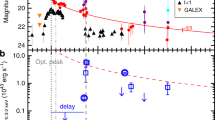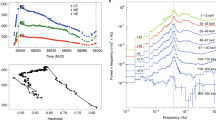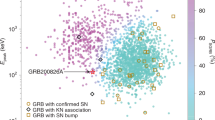Abstract
Black holes in binary systems execute patterns of outburst activity where two characteristic X-ray states are associated with different behaviours observed at radio wavelengths. The hard state is associated with radio emission indicative of a continuously replenished, collimated, relativistic jet, whereas the soft state is rarely associated with radio emission, and never continuously, implying the absence of a quasi-steady jet. Here we report radio observations of the black hole transient MAXI J1820+070 during its 2018 outburst. As the black hole transitioned from the hard to soft state, we observed an isolated radio flare, which, using high-angular-resolution radio observations, we connect with the launch of bipolar relativistic ejecta. This flare occurs as the radio emission of the core jet is suppressed by a factor of over 800. We monitor the evolution of the ejecta over 200 days and to a maximum separation of 10″, during which period it remains detectable due to in situ particle acceleration. Using simultaneous radio observations sensitive to different angular scales, we calculate an accurate estimate of energy content of the approaching ejection. This energy estimate is far larger than that derived from the state transition radio flare, suggesting a systematic underestimate of jet energetics.
This is a preview of subscription content, access via your institution
Access options
Access Nature and 54 other Nature Portfolio journals
Get Nature+, our best-value online-access subscription
$29.99 / 30 days
cancel any time
Subscribe to this journal
Receive 12 digital issues and online access to articles
$119.00 per year
only $9.92 per issue
Buy this article
- Purchase on Springer Link
- Instant access to full article PDF
Prices may be subject to local taxes which are calculated during checkout




Similar content being viewed by others
Data availability
All radio maps used in our analysis are available from the corresponding author on reasonable request. The data used to create the radio–X-ray correlation (Fig. 1) are available in a Source Data file. The AMI-LA data of the radio flare shown in Extended Data Fig. 1 are available in a Source Data file. The authors declare that all other data supporting the findings of this study are available within the paper and its Supplementary Information.
References
Fender, R. P., Belloni, T. M. & Gallo, E. Towards a unified model for black hole X-ray binary jets. Mon. Not. R. Astron. Soc. 355, 1105–1118 (2004).
Corbel, S., Fender, R. P., Tomsick, J. A., Tzioumis, A. K. & Tingay, S. On the origin of radio emission in the X-ray states of XTE J1650−500 during the 2001–2002 outburst. Astrophys. J. 617, 1272–1283 (2004).
Blandford, R. D. & Znajek, R. L. Electromagnetic extraction of energy from Kerr black holes. Mon. Not. R. Astron. Soc. 179, 433–456 (1977).
Blandford, R. D. & Payne, D. G. Hydromagnetic flows from accretion disks and the production of radio jets. Mon. Not. R. Astron. Soc. 199, 883–903 (1982).
Rees, M. J., Begelman, M. C., Blandford, R. D. & Phinney, E. S. Ion-supported tori and the origin of radio jets. Nature 295, 17–21 (1982).
Stirling, A. M. et al. A relativistic jet from Cygnus X-1 in the low/hard X-ray state. Mon. Not. R. Astron. Soc. 327, 1273–1278 (2001).
Dhawan, V., Mirabel, I. F. & Rodríguez, L. F. AU-scale synchrotron jets and superluminal ejecta in GRS 1915+105. Astrophys. J. 543, 373–385 (2000).
Russell, D. M. et al. Testing the jet quenching paradigm with an ultradeep observation of a steadily soft state black hole. Astrophys. J. 739, L19 (2011).
Coriat, M. et al. Radiatively efficient accreting black holes in the hard state: the case study of H1743−322. Mon. Not. R. Astron. Soc. 414, 677–690 (2011).
Rushton, A. P. et al. Disc-jet quenching of the galactic black hole swift J1753.5−0127. Mon. Not. R. Astron. Soc. 463, 628–634 (2016).
Russell, T. D. et al. Disk-jet coupling in the 2017/2018 outburst of the galactic black hole candidate X-ray binary MAXI J1535−571. Astrophys. J. 883, 198 (2019).
Mirabel, I. F. & Rodríguez, L. F. A superluminal source in the galaxy. Nature 371, 46–48 (1994).
Tucker, M. A. et al. ASASSN-18ey: the rise of a new black hole X-ray binary. Astrophys. J. 867, L9 (2018).
Kawamuro, T. et al. MAXI/GSC detection of a probable new X-ray transient MAXI J1820+070. The Astronomer’s Telegram 11399 (2018).
Uttley, P. et al. NICER observations of MAXI J1820+070 suggest a rapidly-brightening black hole X-ray binary in the hard state. The Astronomer’s Telegram 11423 (2018).
Torres, M. A. P. et al. Dynamical confirmation of a black hole in MAXI J1820+070. Astrophys. J. 882, L21 (2019).
Shappee, B. J. et al. The man behind the curtain: X-rays drive the UV through NIR variability in the 2013 active galactic nucleus outburst in NGC 2617. Astrophys. J. 788, 48 (2014).
Kennea, J. A. et al. Swift detection of MAXI J1820+070. The Astronomer’s Telegram 11403 (2018).
Staley, T. D. et al. Automated rapid follow-up of Swift gamma-ray burst alerts at 15 GHz with the AMI Large Array. Mon. Not. R. Astron. Soc. 428, 3114–3120 (2013).
Gandhi, P., Rao, A., Johnson, M. A. C., Paice, J. A. & Maccarone, T. J. Gaia data release 2 distances and peculiar velocities for galactic black hole transients. Mon. Not. R. Astron. Soc. 485, 2642–2655 (2019).
Shidatsu, M. et al. X-ray, optical, and near-infraredmonitoring of the new X-ray transient MAXI J1820+070 in the low/hard state. Astrophys. J. 868, 54 (2018).
Shidatsu, M. et al. X-ray and optical monitoring of state transitions in MAXI J1820+070. Astrophys. J. 874, 183 (2019).
Muñoz-Darias, T. et al. Hard-state accretion disk winds from black holes: the revealing case of MAXI J1820+070. Astrophys. J. 879, L4 (2019).
Kajava, J. J. E. et al. X-ray dips and a complex UV/X-ray cross-correlation function in the black hole candidate MAXI J1820+070. Mon. Not. R. Astron. Soc. 488, L18–L23 (2019).
Kara, E. et al. The corona contracts in a black-hole transient. Nature 565, 198–201 (2019).
Fender, R. P., Homan, J. & Belloni, T. M. Jets from black hole X-ray binaries: testing, refining and extending empirical models for the coupling to X-rays. Mon. Not. R. Astron. Soc. 396, 1370–1382 (2009).
Corbel, S. et al. The ‘universal’ radio/x-ray flux correlation: the case study of the black hole GX 339-4. Mon. Not. R. Astron. Soc. 428, 2500–2515 (2013).
Brocksopp, C., Miller-Jones, J. C. A., Fender, R. P. & Stappers, B. W. A highly polarized radio jet during the 1998 outburst of the black hole transient XTE J1748−288. Mon. Not. R. Astron. Soc. 378, 1111–1117 (2007).
Hjellming, R. M. & Rupen, M. P. Episodic ejection of relativistic jets by the X-ray transient GRO J1655-40. Nature 375, 464–468 (1995).
Hannikainen, D. C. et al. Revisiting the relativistic ejection event in XTE J1550−564 during the 1998 outburst. Mon. Not. R. Astron. Soc. 397, 569–576 (2009).
Atri, P. et al. A radio parallax to the black hole X-ray binary MAXI J1820+070. Preprint at https://arxiv.org/abs/1912.04525 (2019).
Fender, R. P. Uses and limitations of relativistic jet proper motions: lessons from galactic microquasars. Mon. Not. R. Astron. Soc. 340, 1353–1358 (2003).
Longair, M. S. High Energy Astrophysics Ch. 16.4 (Cambridge Univ. Press, 2011).
Bright, J., Motta, S., Fender, R., Perrott, Y. & Titterington, D. AMI-LA 15.5 GHz observations of radio flaring from the black hole candidate MAXI J1820+070 in transition. The Astronomer’s Telegram 11827 (2018).
van der Laan, H. A model for variable extragalactic radio sources. Nature 211, 1131–1133 (1966).
Tetarenko, A. J. et al. Extreme jet ejections from the black hole X-ray binary V404 Cygni. Mon. Not. R. Astron. Soc. 469, 3141–3162 (2017).
Fender, R. & Bright, J. Synchrotron self-absorption and the minimum energy of optically thick radio flares from stellar mass black holes. Mon. Not. R. Astron. Soc. 489, 4836–4846 (2019).
Hannikainen, D. et al. XTE J1550-564: a superluminal ejection during the september 1998 outburst. Astrophys. Space Sci. Suppl. 276, 45–48 (2001).
Corbel, S. et al. Large-scale, decelerating, relativistic X-ray jets from themicroquasar XTE J1550−564. Science 298, 196–199 (2002).
Tomsick, J. A. et al. X-ray jet emission from the black hole X-ray binary XTE J1550−564 with Chandra in 2000. Astrophys. J. 582, 933–944 (2003).
Migliori, G. et al. Evolving morphology of the large-scale relativistic jets from XTE J1550−564. Mon. Not. R. Astron. Soc. 472, 141–165 (2017).
Corbel, S. et al. Discovery of X-ray jets in the microquasar H1743−322. Astrophys. J. 632, 504–513 (2005).
Wang, X. Y., Dai, Z. G. & Lu, T. External shock model for the large-scale, relativistic X-ray jets from the microquasar XTE J1550−564. Astrophys. J. 592, 347–353 (2003).
Zwart, J. T. L. et al. The Arcminute Microkelvin Imager. Mon. Not. R. Astron. Soc. 391, 1545–1558 (2008).
Hickish, J. et al. A digital correlator upgrade for the Arcminute Microkelvin Imager. Mon. Not. R. Astron. Soc. 475, 5677–5687 (2018).
Perrott, Y. C. et al. AMI galactic plane survey at 16 GHz — I. Observing, mapping and source extraction. Mon. Not. R. Astron. Soc. 429, 3330–3340 (2013).
McMullin, J. P., Waters, B., Schiebel, D., Young, W. & Golap, K. CASA architecture and applications. In Astronomical Data Analysis Software and Systems XVI ASP Conference Series Vol. 376 (eds Shaw, R. A. et al.) 127–130 (ASP, 2007).
Offringa, A. R., van de Gronde, J. J. & Roerdink, J. B. T. M. A morphological algorithm for improving radio-frequency interference detection. Astron. Astrophys. 539, A95 (2012).
Fender, R. et al. ThunderKAT: the MeerKAT large survey project for image-plane radio transients. Preprint at https://arxiv.org/abs/1711.04132 (2017).
Offringa, A. R. et al. WSCLEAN: an implementation of a fast, generic wide-field imager for radio astronomy. Mon. Not. R. Astron. Soc. 444, 606–619 (2014).
Martí-Vidal, I., Vlemmings, W. H. T., Muller, S. & Casey, S. UVMULTIFIT: a versatile tool for fitting astronomical radio interferometric data. Astron. Astrophys. 563, A136 (2014).
Gehrels, N. et al. The Swift gamma-ray burst mission. Astrophys. J. 611, 1005–1020 (2004).
Arnaud, K. A. XSPEC: the first ten years. In Astronomical Data Analysis Software and Systems V ASP Conference Series Vol. 101 (eds Jacoby, G. H. & Barnes, J.) 17–20 (ASP, 1996).
Motta, S. E., Casella, P. & Fender, R. P. Radio-loudness in black hole transients: evidence for an inclination effect. Mon. Not. R. Astron. Soc. 478, 5159–5173 (2018).
Drappeau, S. et al. Dark jets in the soft X-ray state of black hole binaries? Mon. Not. R. Astron. Soc. 466, 4272–4278 (2017).
Acknowledgements
J.S.B. acknowledges the support of a Science and Technologies Facilities Council Studentship. E.T. acknowledges financial support from the UnivEarthS Labex programme of Sorbonne Paris Cité (ANR-10-LABX-0023 and ANR-11-IDEX-0005-02). D.A.H.B. acknowledges support by the National Research Foundation. P.A.W. acknowledges support from the NRF and UCT. J.C.A.M.-J. is the recipient of an Australian Research Council Future Fellowship (FT140101082), funded by the Australian government. A.H. acknowledges that this research was supported by a grant from the GIF, the German-Israeli Foundation for Scientific Research and Development. I.H. and D.R.A.W. acknowledge support from the Oxford Hintze Centre for Astrophysical Surveys, which is funded through generous support from the Hintze Family Charitable Foundation. J.M. acknowledges financial support from the State Agency for Research of the Spanish MCIU through the ‘Center of Excellence Severo Ochoa’ award to the Instituto de Astrofísica de Andalucía (SEV-2017-0709) and from the grant RTI2018-096228-B-C31 (MICIU/FEDER, EU).
The MeerKAT telescope is operated by the South African Radio Astronomy Observatory, which is a facility of the National Research Foundation, an agency of the Department of Science and Technology. We thank the staff of the Mullard Radio Astronomy Observatory for their invaluable assistance in the commissioning, maintenance and operation of AMI, which is supported by the universities of Cambridge and Oxford. We acknowledge support from the European Research Council under grant ERC-2012-StG-307215 LODESTONE. We thank the Swift team for performing observations promptly on short notice. The National Radio Astronomy Observatory is a facility of the National Science Foundation operated under cooperative agreement by Associated Universities, Inc. e-MERLIN is a National Facility operated by the University of Manchester at Jodrell Bank Observatory on behalf of STFC. We acknowledge the use of the Inter-University Institute for Data Intensive Astronomy (IDIA) data-intensive research cloud for data processing. IDIA is a South African university partnership involving the University of Cape Town, the University of Pretoria and the University of the Western Cape. We thank the International Space Science Institute in Bern, Switzerland for support and hospitality for the team meeting ‘Looking at the disc–jet coupling from different angles: inclination dependence of black-hole accretion observables’.
Author information
Authors and Affiliations
Contributions
J.S.B. led interpretation of results, wrote a substantial portion of the manuscript, and performed the reduction of the MeerKAT and AMI-LA data. R.P.F. contributed to the interpretation of results and wrote a substantial portion of the manuscript. S.E.M. contributed to the interpretation of results and performed the reduction of the Swift and MAXI X-ray data. J.C.A.M.-J. contributed to the interpretation of results. D.R.A.W., J.M. and R.B. performed the reduction of the eMERLIN data. R.M.P. and J.C.A.M.-J. performed the reduction of the VLA data. J.C.A.M.-J. performed the reduction of the VLBA data. I.H. and E.T. assisted with the reduction of the MeerKAT observational data. D.T., D.A.G., G.R.S., A.J.T., T.D.R. and D.A.H.B. provided useful comments on the manuscript. S.C., J.H., E.G., P.A.W., R.P.A., P.J.G., A.H., A.J.v.d.H., E.G.K., V.A.M., A.R. and R.A.M.J.W. provided useful comments on the manuscript, and were instrumental in the organization and implementation of the ThunderKAT large survey project.
Corresponding author
Ethics declarations
Competing interests
The authors declare no competing interests.
Additional information
Peer review information Nature Astronomy thanks Michael McCollough and the other, anonymous, reviewer(s) for their contribution to the peer review of this work.
Publisher’s note Springer Nature remains neutral with regard to jurisdictional claims in published maps and institutional affiliations.
Extended data
Extended Data Fig. 1 AMI-LA observations of a state transition radio flare from J1820.
AMI-LA observations of a radio flare which occurred as J1820 transitioned from the hard to soft X-ray state. The blue data points correspond to 30 min of (u,v) amplitudes averaged over all baselines and frequencies. The errors on individual points include a statistical error (calculated from the standard deviation of data within the 30 min bin) and a 5% calibration uncertainty, combined in quadrature. Dotted and dashed lines show exponential fits to the core quenching and the rise of the flare, respectively. We use these to estimate the rise time of the flare, which we take as the time between the intercept of these fits and the peak data point of the flare, as well as its start date. Error bars on data points indicate one sigma uncertainties.
Extended Data Fig. 2 A VLBA observation of J1820 from MJD 58306.22.
Contours mark \(140\ \mu {\rm{Jy}}\times {(\sqrt{2})}^{n}\) for n = 3, 4, 5, 6, 7, 8, 9. We mark the position of the core (central red cross; inferred from previous hard state observations) and the measured positions of the approaching (red cross to the right of the core) and receding (red cross to the left of the core) jet from the image. These are given in Supplementary Table 1. The black ellipse in the bottom left corner shows the synthesised beam with a major and minor axis of 0.0009′ and 0.0005′, respectively.
Extended Data Fig. 3 The radio flux density from the approaching radio ejecta over a 150 d period, starting near our inferred ejection.
As with Fig. 4, with the eMERLIN and VLBA data removed. We fit sections of the light curve with exponential decay functions of the form Fν = Ae−Δt∕τ. Data shaded grey are not included in the fitting. The first light curve segment (fast decaying AMI-LA data; MJD 58314 to 58320), is well described (\({\chi }_{\nu }^{2}=1.21\)) by a decay with a characteristic time scale of 6 ± 1d (dashed line). We opt to fit the apparently slower decay (MJD 58324 onward) with a broken exponential function (dotted line). The best fit decay rates are 51 ± 6 d and 21.0 ± 0.9 d, with the break occurring at MJD 58386 ± 4 (\({\chi }_{\nu }^{2}=1.59\)). Error bars on data points indicate one sigma uncertainties.
Extended Data Fig. 4 The angular separation evolution of the approaching and receding jet components.
The angular separation of the approaching (top panel) and receding (bottom panel) ejections from J1820 with time. We jointly fit both the approaching and receding jet motion with two models. Firstly we assume that both components propagate with ballistic motion and were launched simultaneously. For this case we find μapp = 77 ± 1 mas d−1, μrec = 33 ± 1 mas d−1 and tlaunch = 58305.89 ± 0.02 (Δt = 0.21 ± 0.02) (quantities correspond to the approaching jet velocity, the receding jet velocity and the launch time, respectively). The best fit for this model are shown by the solid black lines in the top and bottom panel. Assuming now as above, but allowing for the proper motion of each component to undergo constant deceleration, we find μapp,0 = 101 ± 3 mas d−1, μrec,0 = 58 ± 6 mas d−1, tlaunch = 58306.03 ± 0.02 (Δt = 0.35 ± 0.02), \({\dot{\mu }}_{{\rm{app}}}=-0.49\pm 0.06\ {\rm{mas}}\ {{\rm{d}}}^{-2}\) and \({\dot{\mu }}_{{\rm{rec}}}=-0.33\pm 0.07\ {\rm{mas}}\ {{\rm{d}}}^{-2}\) (quantities correspond to the initial approaching jet velocity, the initial receding jet velocity, the launch time, the deceleration of the approaching jet and the deceleration of the receding jet, respectively). Error bars on data points indicate one sigma uncertainties.
Supplementary information
Supplementary Information
Supplementary discussion and Tables 1–4.
Source data
Source Data Fig. 1
Data to recreate Fig. 1.
Source Data Extended Data Fig. 1
Data to recreate Extended Data Fig. 2.
Rights and permissions
About this article
Cite this article
Bright, J.S., Fender, R.P., Motta, S.E. et al. An extremely powerful long-lived superluminal ejection from the black hole MAXI J1820+070. Nat Astron 4, 697–703 (2020). https://doi.org/10.1038/s41550-020-1023-5
Received:
Accepted:
Published:
Issue Date:
DOI: https://doi.org/10.1038/s41550-020-1023-5
This article is cited by
-
Delayed radio flares from a tidal disruption event
Nature Astronomy (2021)
-
Discovery of oscillations above 200 keV in a black hole X-ray binary with Insight-HXMT
Nature Astronomy (2020)



